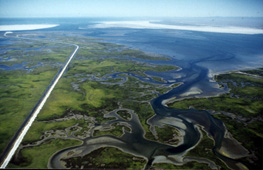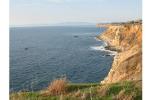 |
 |
 |
 |
 |
 |
 |
Gray Whale Migration Update: February 6, 2002
Today's Report Includes:
- On the Whale Trail
- Field Notes from Laguna Ojo de Liebre
- Classroom to Classroom: Alaska-to-Mexico Exchange
- Try This! Artifacts Photo Quiz
- A Whale of a Baby! Challenge Question #1
- A Letter from Mexico's Salty Lagoons/Link to Lesson
- Pickleheads and Field Notes from Point Vicente, CA
- Southbound Babies: Challenge Question #2
- Reading the Data: Challenge Question #3
|
Gray Whale Migration Route |
It's prime time again for one of the greatest shows in the marine world: the California gray whale's migration from frigid arctic feeding grounds to Mexico's balmy birthing lagoons. This time of year, gray whales are still plowing south by the hundreds. Their 5,000-6,000 mile swim takes them from summer's arctic feeding grounds to warm, sheltered lagoons that provide the ideal place for them to mate and give birth in winter. Only the California gray whale follows a path that's usually within a few miles of shore. That's why the gray whale is seen by more people, in more places, than any other type of whale. Since December, gray whales have been arriving in the four calving and mating lagoons of Mexico's Baja California coast. (Click on the map dots to read more about each lagoon.) As the whales move northward up the coast this spring, we'll be hearing first sightings and news from a network of observers along the way. Welcome to another Journey North!
Field Notes from Laguna Ojo de Liebre
By Journey North science writer Jane Duden
|
Jane (front left) touches the whale. |
 |
|
Gray whale nursery lagoon. Photo courtesy Keith Jones. |
Our small group of eight spent three days of great whale watching in the inner and outer lagoons, whose size was an amazing reminder to me that our planet is 3/4 water. The lagoons may be shallow, but they stretch as far as the eye can see. We practically had the entire lagoon to ourselves, which was another big surprise. It didn't take long for the shouts to begin. "Straight ahead, 12 o'clock!" "Another one, 9 o'clock!" "Mother and baby, left at 2:00!" Whales were spouting in the distance and as close as 20 feet from the boat. Whale spouts were plentiful, and we also saw several dolphins churning up the sea.
I had always heard about the friendly whales, las amistosas, and our awesome encounter came on the last boat trip of our last day. It was the best surprise of all. The wind had picked up, and another group might have turned down the trip. Not us! We got splashed and drenched as we motored around for about an hour, and the wind and chop made it hard to see whales or the spouts that tell us where they are. Also, the whales will generally sink slightly below the surface when it's choppy, instead of laying on top. But suddenly a gnarly, barnacle-scarred female poked her head above the waves about 150 yards off our starboard side. Our pangera, Herieberto, quickly idled the motor and we drifted to a stop, all eyes on the long shape heading towards us in the blue-green water. We bobbed in the water as the friendly female approached our side. She was amazingly gentle and graceful -- and twice the size of our 22-foot boat. In our excitement, we all leaned way over the side. The panga dipped deeply toward the water, and Keith Jones, our leader, hung out over the opposite side to keep us from tipping! This friendly whale stayed by our side for probably five minutes or longer. We could hear her exhale and inhale as she surfaced from swimming under, around, and up to the boat. We were nearly speechless with awe and wonder. She was willing to be near us and to feel our touch, which is a real privilege and honor after the damage humans did to the gray whale population in this very lagoon during the whale-hunting days. It's an encounter I will never, ever forget. In my next report, I'll share a photo journal of the trip. But now, let's see what else happened during this spectacular trip to Mexico!
Classroom to Classroom: Alaska-to-Mexico Exchange
Whale watching wasn't the only reason I went to Baja. This year, Journey North wanted to introduce students at both ends of the whale migration trail so they could help each other learn about the whale's "other" home. We chose a school in the town of Guerrero Negro, about 1/2 hour's drive from Laguna Ojo de Liebre. Our friends in the arctic at Nelson Lagoon School were happy to introduce themselves through letters, photos, and artifacts from the whales' northern home. I took these items to Amado Nervo School on January 22 and the students and their teacher were delighted with every item. In return, the Mexican students prepared letters and items to illustrate their lives in the whales' winter home. You'll get to see many of these things in upcoming reports. For starters, read on.
|
Students at Nelson Lagoon School in Alaska |
6th graders at Amado Nervo School in Mexico |
Try This! Artifacts Photo Quiz
|
From Alaska to Mexico. What are these? |
Photo Quiz: What Did the Alaskan Students Send to Mexico?
A Whale of a Baby! Challenge Question #1
|
Sirena |
"Hi. I'm Sirena Bondy. I'm from Guerrero Negro BCS. I like purple and black. I like dogs and cats. I am 12 years old and I like pop music. I like basketball and soccer. I live in a city that has the biggest salt company in the world. The beaches and dunes are very pretty. The original music here is country-type. The gray whales migrate here to have their calves and rest from the journey of 8000 km. Their time here is from December to April. Did you know that when a gray whale is born it weighs around 800 kg, and when they are big they weigh from 20 to 40 tons?"
For baby whales in the lagoons around Guerrero Negro, the race to build blubber has begun. As a baby, YOU did all your growing on a diet of milk. So do baby whales -- but they may gain more than 60 pounds a day! (How long did it take YOU to gain 60 pounds?) You'll be able to answer our challenge question when you look for clues in "Holy Cow! What a Calf." Find it here:
Challenge Question #1:
"About how much will a calf weigh by the time it is two months old and begins the long migration north? Why is a calf's weight gain important?"
(To respond
to this question, please follow the instructions below.)
A Letter from Mexico's Salty Lagoons
In her letter to students in Nelson Lagoon, Jannyn Irasema Villavicencia Ramirez writes: "I am 12 years old, my school is called Amado Nervo and I am in 6th grade. My favorite sport is basketball, my favorite animal is the dog and my favorite color is red. In Guerrero Negro, in the months of December and March, the whales arrive to have their babies. Many different birds like the Sandpipers ad the Canadian duck also migrate here in December. There is also a salt factory that is the biggest in the world. They transport the salt in huge trucks called Kengors to machines where they wash the salt and grind it to take it to another place where they package it and they export it to different places in the world."
Teacher Tip! Link to Lesson
Warm and salty, the lagoons of Baja California Mexico are more than ideal nurseries for gray whale babies. These lagoons also offer just-right conditions for producing solar-evaporated salt. Where does the salt in your salt shaker or the road de-icers come from? It might come from Laguna Ojo de Liebre, where the whales are now, and where many people in the town of Guerrero Negro earn their living. How does the salt get to people who use it? See fascinating photos of Guerrero Negro's saltworks -- and discover how to make your own saltbeds here:
Pickleheads and Field Notes from Point Vicente, CA
|
Baby gray whales are sometimes referred to as "pickleheads," as their head resembles a giant dill pickle. |
"Once again, this season's Gray whale census run by the Los Angeles Chapter of the American Cetacean Society (ACS) is located at the Point Vicente Lighthouse facility (33.44N,-118.24W), through the generosity of the U.S. Coast Guard 11th District and residents of the Point Vicente Lighthouse facility. The Census runs from 1 December through 15 May during daylight hours, seven days a week. It is manned by teams of trained volunteers from the ACS, the Cabrillo Whale Watch Program, and the general public. This season's census got off to a great start on December 1st with the sighting of two gray whales before 7 a.m., although the rest of the day brought no more sightings. On December 2nd we had another surprise when we sighted our first northbound gray whale -- a juvenile, still learning the ropes about migrating.
|
From ACS viewing platform |
"So far, this season's overall sightings have been slightly higher than last season. Our mother & baby (cow/calf) southbound sightings are in fact slightly higher than average. [These calves were born on the migration south.] We sighted our first southbound pair on December 20th, but overall we are we are about 32% below average for our season to date. Once again we can only speculate why our numbers are low again.
- Are we seeing a shift in the migration route, with whales migrating further offshore?
- Are there as many gray whales as we are lead to believe?
- Are fewer gray whales migrating all the way to Baja? Some may be just migrating part of the way in order to find food. Only time will tell if these fewer sighting are temporary or permanent."
Southbound Babies? Challenge Question #2
Southbound Babies? Mike and Winston said, "Our mother & baby (cow/calf) southbound sightings are in fact slightly higher than average." That makes us wonder. . .
Challenge Question #2:
"What might be some difficulties for baby whales born during the southbound migration instead of in the warm, shallow lagoons?"
(To respond to
this question, please follow the instructions below.)
Reading the Data: Challenge Question #3
We've made two charts to give you some math practice with migration data. One chart shows this year's migration sightings from January 21 to February 4. The second chart shows averages from the past ten years for the week Jan. 25-Feb. 1.
Challenge Question #3:
"How many southbound gray whales did ACS count BEFORE January 23? Compare the number of southbound whales for Jan 25-Feb 1, 2002 to the AVERAGE number of southbound whales for the same week over the last ten years."
(To respond
to this question, please follow the instructions below.)
TIP: You can keep up with the daily gray whale
census counts for yourself (great for graphing!) on the ACS Web site:
How to Respond to Today's Challenge Questions:
IMPORTANT: Answer only ONE question in each e-mail message.
1. Address an e-mail message to: jn-challenge-gwhale@learner.org
2. In the Subject Line of your message write: Challenge Question #1 (or #2, or #3).
3. In the body of EACH message, give your answer to ONE of the questions above.
The Next Gray Whale Migration Update Will Be Posted on February
20, 2002.
Copyright 2002 Journey North. All Rights Reserved.
Please send all questions, comments, and suggestions to our feedback form









